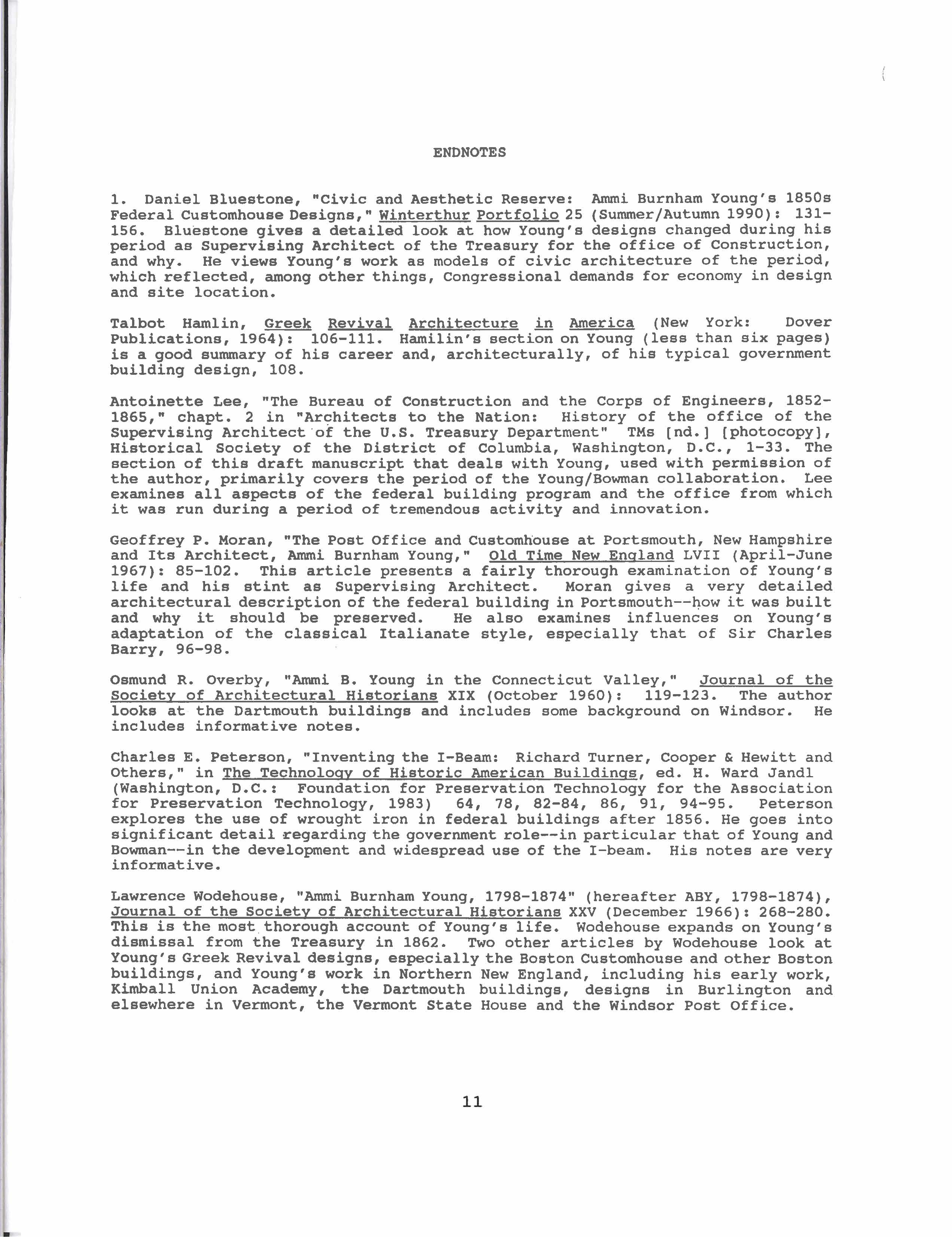

(Continued from Page 10)
ENDNOTES
1. Daniel Bluestone, "Civic and Aesthetic Reserve: Ammi Burnham Young's 1850s Federal Customhouse Designs," Winterthur Portfolio 25 (Summer/Autumn 1990): 131-156. Bluestone gives a detailed look at how Young's designs changed during his period as Supervising Architect of the Treasury for the office of Construction, and why. He views Young's work as models of civic architecture of the period, which reflected, among other things, Congressional demands for economy in design and site location.
Talbot Hamlin, Greek Revival Architecture in America (New York: Dover Publications, 1964): 106-111. Hamilin's section on Young (less than six pages) is a good summary of his career and, architecturally, of his typical government building design, 108.
Antoinette Lee, "The Bureau of Construction and the Corps of Engineers, 1852-1865," chapt. 2 in "Architects to the Nation: History of the office of the Supervising Architect'of the U.S. Treasury Department" TMs [nd.] [photocopy], Historical Society of the District of Columbia, Washington, D.C., 1-33. The section of this draft manuscript that deals with Young, used with permission of the author, primarily covers the period of the Young/Bowman collaboration. Lee examines all aspects of the federal building program and the office from which it was run during a period of tremendous activity and innovation.
Geoffrey P. Moran, "The Post Office and Customhouse at Portsmouth, New Hampshire and Its Architect, Ammi Burnham Young," Old Time New England LVII (April-June 1967): 85-102. This article presents a fairly thorough examination of Young's life and his stint as Supervising Architect. Moran gives a very detailed architectural description of the federal building in Portsmouth--how it was built and why it should be preserved. He also examines influences on Young's adaptation of the classical Italianate style, especially that of Sir Charles Barry, 96-98.
Osmund R. Overby, "Ammi B. Young in the Connecticut Valley," Journal of the Society of Architectural Historians XIX (October 1960): 119-123. The author looks at the Dartmouth buildings and includes some background on Windsor. He includes informative notes.
Charles E. Peterson, "Inventing the I-Beam: Richard Turner, Cooper and Hewitt and Others," in The Technology of Historic American Buildings, ed. H. Ward Jandl (Washington, D.C.: Foundation for Preservation Technology for the Association for Preservation Technology, 1983) 64, 78, 82-84, 86, 91, 94-95. Peterson explores the use of wrought iron in federal buildings after 1856. He goes into significant detail regarding the government role--in particular that of Young and Bowman--in the development and widespread use of the I-beam. His notes are very informative.
Lawrence Wodehouse, "Ammi Burnham Young, 1798-1874" (hereafter ABY, 1798-1874), Journal of the Society of Architectural Historians XXV (December 1966): 268-280. This is the most thorough account of Young's life. Wodehouse expands on Young's dismissal from the Treasury in 1862. Two other articles by Wodehouse look at Young's Greek Revival designs, especiallythe Boston Customhouse and other Boston buildings, and Young's work in Northern New England, including his early work, Kimball Union Academy, the Dartmouth buildings, designs in Burlington and elsewhere in Vermont, the Vermont State House and the Windsor Post Office.
(Continued on Page 12)
This site is sponsored by the Friends of the Old Naval Hospital
Last updated September 27, 2009